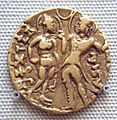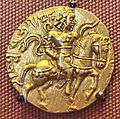Gupta Empire facts for kids
The Gupta Empire was a powerful kingdom in ancient India, lasting from around 320 to 550 AD. It covered much of North-central India, including parts of modern-day India and Bangladesh. This period is often called the Golden Age of India. During this time, there were amazing advancements in science, mathematics, astronomy, religion, and philosophy.
Many historians compare the Gupta Empire to other great ancient civilizations. These include the Han Dynasty and Tang Dynasty in China, and the Roman Empire. The Guptas likely came from the Bengal region. In the early 300s, they ruled smaller Hindu kingdoms in areas like Magadha and Uttar Pradesh.
We know a lot about the Gupta Empire from various sources. These include ancient coins, stone carvings, grand monuments, and writings in Sanskrit. The Gupta rulers were strong leaders and good at managing their empire. This led to a time of great wealth and growth in culture. Gupta society followed Hindu traditions, which included a clear social class system. Later, a series of invasions weakened the empire. However, many of their brilliant ideas and achievements were preserved and shared with other cultures. They continue to influence us even today.
Contents
Who Were the Gupta Rulers?
The Gupta dynasty was the family that ruled the Gupta Empire. They were in charge from about 320 to 550 AD.
Some of the most important rulers of this dynasty included:
- Samudragupta
- Chandragupta II
- Kumaragupta I
- Skandagupta
- Narasimhagupta
- Buddhagupta
- Vishnugupta
The Golden Age of India
The Gupta period is famous for being a "Golden Age." This means it was a time of great progress and creativity.
Amazing Discoveries in Science and Math
During the Gupta Empire, Indian scholars made huge strides. They developed the concept of zero, which is super important in math today. They also created the decimal system, which uses ten digits (0-9). This system is now used all over the world.
Astronomers studied the stars and planets. They figured out that the Earth is round and spins on its axis. They also understood that the Earth goes around the Sun. These ideas were very advanced for their time.
Art, Architecture, and Literature
The Gupta era saw beautiful art and architecture. Many stunning temples and sculptures were built. These often showed Hindu gods and goddesses. The famous Ajanta Caves and Ellora Caves have amazing paintings and carvings from this period.
Literature also thrived. Famous poets and playwrights wrote many classic works in Sanskrit. These stories and plays are still enjoyed today.
Strong Government and Trade
The Gupta rulers created a stable and well-organized government. This helped the empire to prosper. They encouraged trade, both within India and with other countries. This brought wealth and new ideas into the empire. People generally lived well and had enough to eat.
Society and Culture
Gupta society was largely based on Hindu beliefs. People were organized into different social groups, or classes. This system was called the varna system. Each group had its own duties and roles.
While Hinduism was very important, other religions also existed. Buddhism and Jainism were also practiced. The rulers often supported different faiths. This led to a mix of religious ideas and practices.
Decline of the Empire
After a long period of success, the Gupta Empire began to weaken. This was mainly due to invasions from groups like the Hunas (a branch of the Huns). These invasions drained the empire's resources. They also caused instability.
By the mid-6th century, the empire had broken into smaller kingdoms. However, the cultural and intellectual achievements of the Gupta Golden Age continued to influence India for centuries. Many of their ideas spread to other parts of Asia and beyond.
Images for kids
-
Queen Kumaradevi and King Chandragupta I, depicted on a gold coin.
-
Standing Buddha in red sandstone, Art of Mathura, Gupta period circa 5th century CE. Mathura Museum.
-
An 8 gm gold coin featuring Chandragupta II astride a caparisoned horse with a bow in his left hand.
-
The current structure of the Mahabodhi Temple dates to the Gupta era, 5th century CE. Marking the location where the Buddha is said to have attained enlightenment.
-
Buddha from Sarnath, 5–6th century CE
-
The Colossal trimurti at the Elephanta Caves
-
Nalrajar Garh fortification wall in Chilapata Forests, West Bengal, is one of the last surviving fortification remains from the Gupta period, currently 5–7 m high
-
Nalanda university was first established under Gupta empire
See also
 In Spanish: Imperio Gupta para niños
In Spanish: Imperio Gupta para niños



















